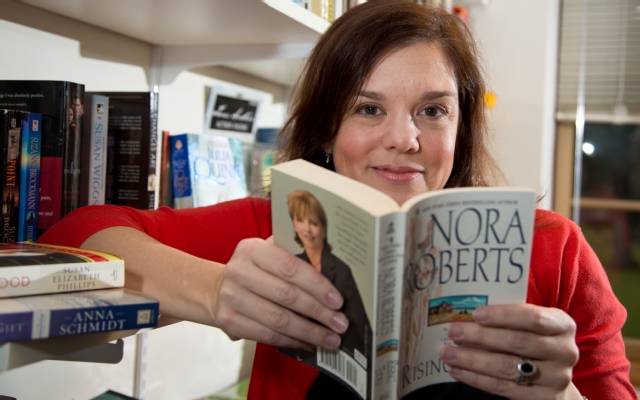
Professor Joanna Gregson did research into writers of romance novels and found herself intrigued and surprised. (John Froschauer, Photographer)
Romancing the readers isn’t that easy, prof discovers in research project
It all started when a box of pink and lavender romance novels arrived at Professor of Sociology Joanna Gregson’s office.
The box came from a friend and fellow sociology professor with whom Gregson attended graduate school. It was in response to a conversation the two had a few days earlier: Have you ever read a romance novel?
Gregson hadn’t. And she would fully admit that she was like many other people: She assumed romance novels were easy reads, brainless formulaic pop.
Then, the box of novels arrived. She read one. And a research topic was born.
Gregson and her friend, professor Jennifer Lois of Western Washington University, decided they wanted to study the writers of the romance genre, of which about 95 percent are women. Sure, the novels had been the subject of research – but, as Gregson would soon find out, nobody had studied the people who actually wrote them.
“Why hasn’t it been studied?” Gregson asked herself. “Like a lot of work that women do, I don’t think it has been taken seriously as an occupation.”
As a sociologist who specialized in sex and gender issues, the subject seemed perfect. And as a field researcher – someone who conducts research on location, first-hand – Gregson knew she had to dive in, head first.
So she and Lois joined the 10,000-member strong Romance Writers of America and began attending monthly meetings in Seattle and annual nationwide conventions, where, as you might expect from a group comprised almost exclusively of women, they were warmly welcomed into the fold.
And, naturally, they started writing their own romance novels.
It’s been a couple of years now, and Gregson is still about 40 pages into her novel. (Don’t expect anything, she warns.) But from the standpoint of getting the dish on the people who write these extremely popular, yet often marginalized, novels – that’s another story.
So far, Gregson and Lois have interviewed more than 45 romance authors, agents, reviewers, publishers and editors – from New York Times bestselling authors to those who are on the cusp of publication. She has delved into all the subgenres of this type of commercial fiction – historical romance, paranormal romance, romantic suspense, inspirational romance. Even Amish romance. (Really.)
When Gregson started the project, she assumed the subject matter would be squarely in her sex-and-gender wheelhouse. Essentially, she’d find out: Who are these women who write these novels? And how do they decide to create the characters that they do? What she found, however, is that romance authors aren’t thinking about gender archetypes. They want to tell a compelling story, just like any author.
Gregson and Lois recently presented her findings at the Romance Writers of America national conference in Atlanta this summer, and they received an enthusiastic reception. Their research has been mentioned on countless author blogs and Twitter feeds, featured in podcasts, and they have been asked to write guest blogs for Random House and USA Today. The pair also have a Facebook page and Twitter feed to update fans on their research.
Gregson finds most interesting the idea of the stigmas associated with these novels. After all, she admits even she had her own stereotypes before she read them. She knows her misperceptions are hardly unique.
“We’ve interviewed New York Times bestselling romance authors who still get told, ‘That is so great you are successful at this, maybe someday you’ll write a real book,’” Gregson said.
Gregson will continue to dig into how the authors deal with these slights, and how an entire professional group seeks to gird themselves against a common perception.
In the mean time, Gregson and Lois will continue their interviews and begin presenting their academic findings. Just don’t expect the novel anytime soon.


